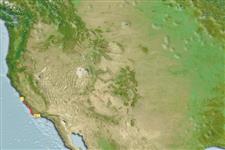>
Perciformes/Zoarcoidei (Eelpouts and pricklebacks) >
Stichaeidae (Pricklebacks) > Stichaeinae
Etymology: Ernogrammus: Greek, ernos, -eos, -ous = bud, shoot, descendenat + Greek, gramma = letter, mark, signal (Ref. 45335); walkeri: Named for B.W. Walker (UCLA) who discovered the species..
Environment: milieu / climate zone / depth range / distribution range
Écologie
marin démersal; profondeur 1 - 21 m (Ref. 26664). Subtropical
Eastern Central Pacific: California, USA.
Taille / Poids / Âge
Maturity: Lm ? range ? - ? cm
Max length : 28.8 cm SL mâle / non sexé; (Ref. 26664)
Description synthétique
Morphologie | Morphométrie
Épines dorsales (Total): 50 - 51; Épines anales 2; Rayons mous anaux: 31 - 33; Vertèbres: 53 - 55. Tubule processes of the lateral line canals are inclined irregularly, postdorsally, and postventrally; unbanded pectorals; branchiostegal membrane separate from isthmus.
Inhabits the littoral and sublittoral zones; apparently nocturnal and lives in rock crevices (Ref. 26664).
Life cycle and mating behavior
Maturité | Reproduction | Frai | Œufs | Fécondité | Larves
Follett, W.I. and D.C. Powell, 1988. Ernogrammus walkeri, a new species of prickleback (Pisces: Stichaeidae) from south-central California. Copeia 1988(1):135-152. (Ref. 26664)
Statut dans la liste rouge de l'IUCN (Ref. 130435)
Menace pour l'homme
Harmless
Utilisations par l'homme
Plus d'informations
Noms communsSynonymesMétabolismePrédateursÉcotoxicologieReproductionMaturitéFraiRassemblement de ponteFéconditéŒufsDéveloppement de l'œuf
Taille/ÂgeCroissanceLongueur-poidsLongueur-longueurFréquences de longueursMorphométrieMorphologieLarvesDynamique des populations larvairesRecrutementAbondanceBRUVS
RéférencesAquacultureProfil d'aquacultureSouchesGénétiqueElectrophoresesHéritabilitéPathologiesTraitementNutrientsMass conversion
CollaborateursImagesStamps, Coins Misc.SonsCiguateraVitesseType de nageSurface branchialeOtolithesCerveauxVision
Outils
Articles particuliers
Télécharger en XML
Sources Internet
Estimates based on models
Preferred temperature (Ref.
123201): 14 - 15.9, mean 15.3 °C (based on 14 cells).
Phylogenetic diversity index (Ref.
82804): PD
50 = 0.6250 [Uniqueness, from 0.5 = low to 2.0 = high].
Bayesian length-weight: a=0.00380 (0.00165 - 0.00876), b=3.16 (2.96 - 3.36), in cm total length, based on LWR estimates for this (Sub)family-body shape (Ref.
93245).
Niveau trophique (Ref.
69278): 3.4 ±0.5 se; based on size and trophs of closest relatives
Résilience (Ref.
120179): Faible, temps minimum de doublement de population : 4,5 à 14 années (Preliminary K or Fecundity.).
Fishing Vulnerability (Ref.
59153): Low to moderate vulnerability (25 of 100).
